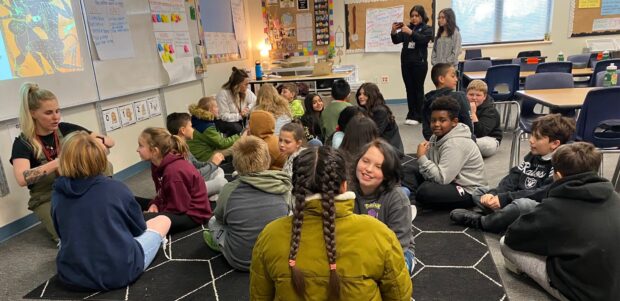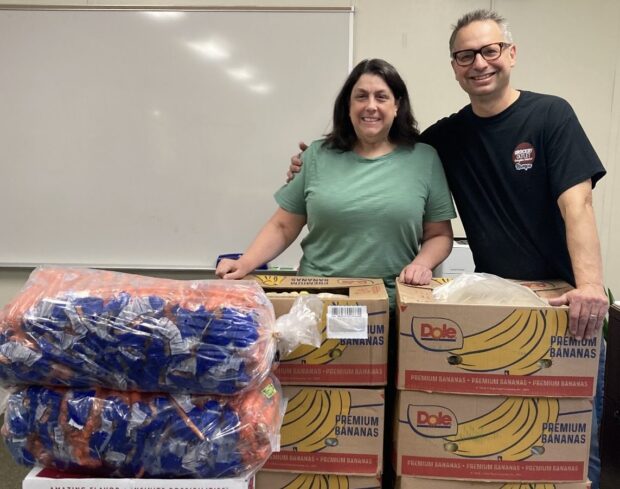Note: This story is one of three on where Idaho’s at-risk students are thriving and what those districts and charters are doing differently. Learn about where those bright spots are, one district’s unique approach to Mondays, and another’s innovative support system for students, teachers, and community members.
NAMPA — “You are respected, valued, and loved.”
That’s the message kids at Endeavor Elementary hear each morning, and a mantra that’s oft-repeated by staff and students alike.
That caring environment is no accident — Endeavor, and Nampa School District as a whole, have thoughtfully created a system of innovative approaches aimed at helping students, staff, and community members.
If families or students need clothing, food, housing, medical care, or counseling, the district will help.
The same goes for teachers. At Endeavor, on-site therapy sessions (provided during work hours) and on-site daycare are provided to make sure teachers can give students their best each day.
“We are always looking to not just support the kids, but support the parents, guardians and adults that are trying to help those kids,” Scott Knopp, the district’s director of curriculum and instruction, said. “It really takes a village when you have some of these poor kiddos who have had some real tough circumstances thrown at them.”
Community resource centers, a co-teaching model, and pioneering student support are helping the district’s at-risk students to succeed above and beyond their peers in other parts of the state.
EdNews mined 2022 Idaho Standards Achievement Test data to see where the most at-risk students were performing well, and Nampa School District was among the standouts. Its at-risk students outperformed state averages for proficiency in six different areas. In four different areas, its at-risk students performed in the top 10 of all districts statewide.
| Student group/subject area | Statewide % of students who scored proficient or better | Nampa School District % of students who scored proficient or better |
| In foster care/ELA | 28.9 | <48 |
| African-American/math | 19.1 | <37 |
| In foster care/math | 17.6 | <48 |
| African-American/science | 16.1 | <48 |
| Migrant/science | 13.2 | <21 |
| With limited English proficiency/science | <5 | <6 |
*Top ten scores are bolded
At Endeavor, one of the ways the leadership supports those students is by supporting teachers.
Free, on-site therapy for teachers: a place to share “frustrations, worries, happy moments, struggles, and challenges”
After the pandemic, teachers were experiencing high levels of stress. Trista Jackson, a social worker at Endeavor Elementary, took notice and decided to help them.
Jackson realized that the school had counseling and therapy services in place for students, but none for teachers. So, Jackson worked with her administrator and nonprofit organizations to bring a therapist to the school — specifically for teachers — every week.
Now, at least 20 teachers at the school regularly see the therapist every week or every other — and they do it during the school day.
Especially for parents, “the last thing that you have time for is going to an hour session after work to deal with the things that you’ve had to deal with at work,” Jackson said.
Shel works hard to protect teachers’ much-needed prep time, so the sessions are held during class time, when an AmeriCorps volunteer, student teacher, or staff member steps in to cover for the teacher while they are in their therapy session.
And the sessions are free. What’s not covered by insurance is paid for with a grant from Project LAUNCH, a program guided by a number of federal partnerships that aims to promote the wellness of young children so they “enter school ready to learn and able to succeed.”
“How do you make teachers feel valued and loved so that they’re ready to come to work and give their all to students, especially our students that are high needs and need somebody that’s willing to ride it out with them?” — Trista Jackson, social worker, Nampa School District
Jackson recently collected feedback from teachers participating in the therapy, and here’s what they had to say about its benefits:
- “I’ve been healthier and lighter on the inside, and in turn am doing so much better on the outside, including work. I can be my best self.”
- “Being a teacher requires resilience. In order to continue in my profession, I need support and tools from my counselor.”
- “As educators we deal with so many factors during the day, yet when we go home, we often find it hard to turn off these thoughts, ideas, and even fears: ‘Did I do enough for my students today? Was I too harsh in my reprimands? Does student x have dinner at home tonight?’ These are some of the thoughts outside of the academic day that we ponder on late in the evenings as we feed and put our own families to bed. Counseling has allowed me to share my frustrations, worries, happy moments, struggles, and challenges.”
- “It’s improved my willingness to work through hard situations.”
- “It’s increased my happiness and enjoyment at work.”
Jackson said she is focused on teacher retention this school year: “I have been working hard on trying to implement ways to keep qualified and effective teachers, because if you want to help kids that are struggling, that is what you need in a building.”
One key question has been guiding her efforts: “How do you make teachers feel valued and loved so that they’re ready to come to work and give their all to students, especially our students that are high needs and need somebody that’s willing to ride it out with them?”
Therapy sessions have been part of the answer; another is on-site childcare.
On-site childcare is a “dream” for moms who teach
Jackson remembers coming back to work after becoming a first-time mom.
“I almost quit because it wasn’t worth it to leave my kiddos,” she said.
But now she doesn’t have to choose. She takes her now 2-year-old son to Endeavor’s on-site daycare. The daycare is a nonprofit that was started by two part-time staff members at the school who saw a need for it.
“(At Endeavor) we have a lot of new moms and a lot of young teachers getting ready to go into motherhood,” Jackson said.
For her and other moms, the daycare has been a “blessing” and a “dream.”
The daycare is more affordable than other options, and moms can go visit their children or breastfeed their infants several times throughout the day.
“It’s one of the reasons I’ve stayed at a hard school,” Jackson said.
And when teachers stick around, that creates much-needed consistency and predictability for kids.
“The biggest thing that I’m proud of at Endeavor is our focus on teacher wellness, because it has a trickle-down effect on to students,” Jackson said.
There are plenty of supports in place to help students, too — including a unique co-teaching model.
Co-teaching is “the greatest thing,” provides students with more chances to have their needs met
Deserae Gibb, a fifth grade teacher at Endeavor, describes her workplace as “a school like no other.”
Some of her students have parents who are incarcerated, others are homeless. Some are English language learners, have disabilities, or learn at a different pace than their peers.
“But man, they are the easiest kids to love … no matter what they come in with, we love and value them for who they are,” Gibb said.
One thing that’s helped them all — the co-teaching model that’s been adopted at Endeavor.
“Every student deserves to be seen and to be met where they’re at in terms of their education, and the best way of doing that is through co-teaching,” Gibb said.
Gibb teaches reading to three sections of fifth graders each day, and during those sessions, co-teacher Sarah Ziemer joins her. Ziemer is a language specialist, and when working together, the two are better able to meet all learners’ needs.
“We teach them strategies and tools for how to access a text that might seem really daunting, whether it’s lengthy or full of juicy vocabulary,” Gibb said. “The co-teaching model really just helps foster students’ love for accessing a text at any level.”

They work side by side, splitting up as needed to provide individual attention to a student or facilitate small groups.
Without co-teaching, one group suffers more than the other, Gibb said. Students are held back while teachers help or review concepts with other students, or students who need more time to master content are rushed.
“You’re kind of forced to choose, like ‘Which group do I want to help flourish?’” she said. “With co-teaching, we have the ability to have two lessons running at once if we need to.”
Gibb and Ziemer benefit too — they can bounce ideas off each other and learn from each other. And if one is having an off day, the other can pick up the ball.
“It’s been the best way to learn to be a better educator … and to continue to develop as a professional” Gibb said.
Other districts have come to observe Endeavor’s co-teaching model and are interested or have started implementing it.
“We’re hoping that the leaders in our community and in education really see the value in it because it’s the greatest thing,” Gibb said.
But co-teaching isn’t the only student support at Endeavor. Teachers also use trauma-informed approaches, or keeping in mind the whole child and their background/lived experiences when teaching.
At Endeavor, that entails:
- A morning check-in where students can share their struggles and successes
- Daily reaffirmation that students are valued, respected, and loved
- Consistent, predictable routines
- A corner of every classroom dedicated to cooling down when a child self-assesses and feels they need to step away when agitated, upset, or frustrated
“My teachers are just putting in the work building their relationships with each and every student, from our kids that don’t have a ton of need to the kids that have experienced horrific things and they put their heart and soul in it,” Jackson said.
When families hit bumpy roads, community resource centers offer food, clothing, medical care, and more
The Nampa School District provides for families and community members, too.
Four of its schools are home to family community resource centers, which provide food, hygiene products, school supplies, clothing, diapers, and household goods to those in need. And each center has a full-time coordinator to oversee it.
Elia Lopez, the coordinator of one such center at Snake River Elementary School, said she also helps community members apply for low-income housing, rental assistance, birth certificates, and employment.
And that’s not even a full list of goods and services provided.
“You could be here all day if we told you how many different things that we (provide),” Lopez said.

Community partners help make these centers possible. One of them is Grocery Outlet, which provides food on a weekly basis — more if needed — to the centers. Daniel Panasiuk, owner of the Nampa store, said it feels good to help those in the neighborhood.
“It’s important for businesses to take care of families in our area,” he said. “It’s kind of our job.”

Lopez described one woman who only comes in for help when it’s an “absolute need,” and on those occasions, she always gets teary-eyed. Without places like the centers, she tells Lopez she couldn’t always make it to her next paycheck.
“A lot of our families hit some bumpy roads … people are just super, super thankful that we’re available and that we’re willing to help,” Lopez said. “If we can support our families to be successful, then those families can support their kids … (who can then) strive to have a better education.”
The centers’ goals are to reduce barriers to education and keep kids in school, and Lopez said absenteeism does go down when kids’ basic needs are met.
“It’s a huge team effort,” Lopez said.
More reading: In a district with unique Mondays, at-risk students outperform state averages
